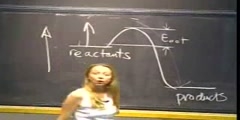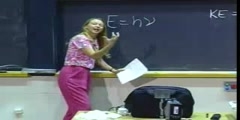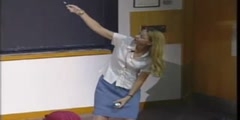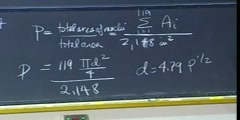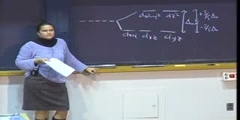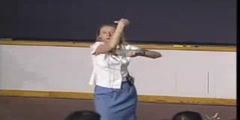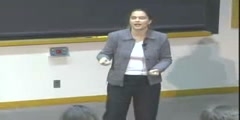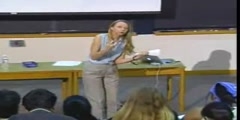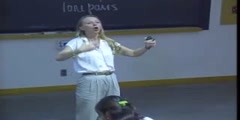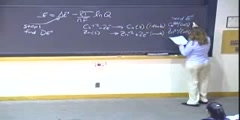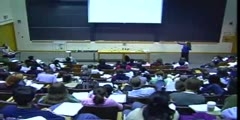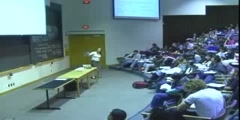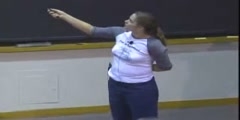Chemical Science - Matter As a Wave - Lecture 5
Chemical Science/n * Email this page/nVideo Lectures - Lecture 5/nTopics covered: /nMatter As a Wave/nInstructor: /nProf. Sylvia Ceyer/nTranscript - Lecture 5/nWhere were we last time? Last time we had discovered, and we're going back to Lecture 4 notes because I think I have a little bit left on Lecture 4 notes, that radiation also behaves like a particle./nAnd it behaves like a particle as exhibited in this photoelectric effect. That is in order to get an electron out, what we needed to do was to put in a particle of energy. We needed to put in a packet of energy./nWe needed to put in a quantum of energy. And as long as that quantum of energy, that packet of energy, that particle of energy was larger than the work function, we would get one electron out for every packet we put in./nThat's an example of the particle-like nature to radiation, this photoelectric effect. But Einstein also went on to show an even more convincing property of the particle-like nature of radiation or a photon./nAnd that is he showed that a photon has momentum even though a photon does not have mass, or essentially no rest mass. And, of course, momentum is a very particle-like property. P for momentum is equal to the mass times velocity./nIf a photon, if radiation has momentum then it's acting very much like a particle. How did he do this? Well, Einstein took the relativistic equations of motion, which he himself wrote down. And what he showed from that is that a photon had momentum P here./nAnd the momentum of the photon is defined by the frequency of the radiation. That is that momentum was given by h, again Planck's constant there, that quantization constant times the frequency over the speed of light./nAnd since, of course, we know the relationship between the frequency and the wavelength, we can write the momentum of a photon as h over lambda. So, if you have radiation of some wavelength lambda, that radiation, those photons have this momentum h over lambda, this photon momentum, even though photons don't have mass./nAnd the actual demonstration of this took experimentally took a few more years. And it was demonstrated first is something called the Compton Effect, which was the interaction of an x-ray photon with some matter./nAnd you could see it, transfer momentum. And I've got to show you here this website from the University of Colorado again. And this is just a video of a photon gun here shooting photons. And here is this enemy atom coming at you./nAnd you're shooting these photons. And, sure enough, you can repel that atom and make it go the other direction because of the moment of the photon. But, of course, if you lower the power, and you're not really good with your fingers here, you can get clobbered./nHere now I am going to try this again. This is almost too easy. Now I lower the power so that the rate of the photons are much slower and I am going to be able to turn this guy around. No problem./nThere we go. Repelled it right off. Let me see if I can get this guy here, I got clobbered. [LAUGHTER] Well, you'll be better at that game than I am. It is just that phenomena. What I am showing you here, that led to the experimental feat of atom trapping, is trapping an atom in space./nHow do they do that? Well, what they did is they took some unsuspecting atom and they came in with some photons, a high power laser beam directed in this way. And, of course, that pushed this atom down./nBut now if you come in with the laser beam in that direction, all the photon momentum is going to push the atom up so now you constrained it in this dimension. And you send another laser beam this way and another one this way, and now you've constrained it in this dimension./nAnd then you send the laser beam in this way and a laser beam in that way and constrained it in the third dimension. You've trapped an atom in space via photon momentum. And this is what Steve Chu and Stanford and Bill Phillips at NIST did in the middle 1990s and received a Nobel Prize for this atom trapping here in 1977./nNo, 1997. Sorry. Photon has momentum. And the reason this is so important, the reason this experiment was also so important is because it is the first step in producing a Bose-Einstein condensate./nA Bose-Einstein condensate is where you take an atom which is a boson actually, and you cool it down to such low temperatures that these atoms condense. So, you've got to cool it down very much so. You have to get to the micro Kelvin range./nAnd the first step in cooling an atom down is this laser atom trapping. This will get you down to Kelvin or a little bit lower or so. And, of course, what I mean by lowering the temperature is that I've slowed this atom down./nThe temperature of the gas related to how fast this atom is moving, if I slow it down, I am cooling the gas. This here is that first step in getting the atom to condense. It's the first step in cooling the gas down./nThen there are many other steps. And, actually, the boson condensate, one of the individuals who accomplished that feat is right here in the Physics Department. One of my colleagues, Wolfgang Ketterle./nMany of you will get to meet Wolfgang Ketterle. In fact, he might even be teaching a section of 8.01. Is that right? Pardon. Recitation, OK. Great. Maybe he will tell you some more about it, if he hasn't already./nSo, photons have momentum. Now, what have we seen? Well, what we have seen is that radiation exhibits both the wave-like behavior and this particle-like behavior. And, just in general experiments, where the radiation produces a change in matter like the photoelectric effect, that's a change in matter, right? An electron gets ripped off of the material./nExperiments in which a change in the matter is effected. In that case, usually the radiation exhibits particle-like behavior, experiments in which the radiation interaction results in a change in the spatial distribution of the radiation./nWell, in that case then radiation exhibits its wave-like behavior. And so it's not really a proper question or an appropriate question to ask whether light is a particle or is it a wave. The appropriate question is to ask whether light behaves like a particle or behaves like a wave, depending on the particular experimental conditions./nNow, this kind of wave-particle duality, or the ability of it to behave like a wave or a particle is not a contradiction. It's just the fundamental nature of light. It might seem like a contradiction to you because your everyday experiment doesn't allow you to see that both properties can be there./nYour everyday experience says it's a particle or it's a wave, but this is a part of nature, of our world that you don't have the experience with every single day so it seems strange. But it is the way light works./nIt's like someone asked me what is the form of a photon? And when you ask that question that's fine, but you have to realize what you want for an answer is to draw an analogy between that photon in something that you can experience everyday./nAnd the bottom line is you cannot draw that analogy correctly because that photon is not something that you can relate correctly to your everyday experience. It's a different part of nature. It's just one that you don't see every day so it seems strange./nYou have to be willing to accept kind of new rules, new phenomena that are just outside of your everyday experience. They're out there. As you delve into nature more deeply you will see that. OK, so we've taken care of radiation, the wave-particles duality of light and matter./nNow what we've got to do is we've got to talk about matter, and we've got to talk about its wave-like properties and also its particle-like properties. Well, it's particle-like properties are certainly something that is within your everyday experience./nYou can understand matter as a particle. What's more difficult to understand is matter behaving like a wave. For example, if you had a situation where you have the surface of a nickel crystal. And what I am showing you right here are two nickel atoms, just two nickel atoms of this surface here./nAnd the two nickel atoms are spaced about 2 time 10 to the minus 10 meters from each other, given the lattice spacing of a nickel crystal. And now if I went and I sent electrons into this nickel surface, again, I'm just showing you two of the atoms./nIf I came in with electrons, electrons are particles because J.J. Thompson showed us that. Eventually the mass of those electrons was determined. But what you might expect is that those electrons would come in and then backscatter from the surface atoms and do so in all directions so that out here, where we have a phosphor screen, and now that screen happens to be curved just so it will be easier for us to talk about the geometry of this problem here, you might expect naively that these electrons scatter in all direction./nAnd everywhere, where they hit, the screen the screen lights up. Well, this is just the experiment that Davidson and Germer did in 1927, along with George Thompson, so the son of J.J. Thompson. Actually, G./nThompson did the experiment in a little different way than Davidson and Germer. And I am going to explain the Davidson and Germer experiment here. And now what I've done is I've taken my nickel atoms and just made them smaller, and I did so because I need to clean up this diagram a little bit for the geometry that we're going to do but left the lattice spacing accurate here./nAnd what Davidson and Germer did was to bring in an electron beam at 54 electron volts. And they looked to see how these electrons scattered back from that surface onto that screen. And, low and behold, what they found was that those electrons did not scatter isotropically./nThey did not go in all directions, but there seemed to be a preferred scattering angle here. And one of those scattering angles right here is 50.7 degrees. This angle right in here, that's the angle from the surface normal to the direction in which this electron scatters./nThey observed some scattered intensity, lots of electron flux at this angle here, about 50.7 degrees. And they observed a lot of intensity right at the normal angle, right here. So, the electron comes in and scatters right back./nAnd, depending on the experimental conditions, they observed some intensity at a very large scattering angle here. What does this look like? It looks like interference phenomena, right? It looks like the results of the two-slit experiment that we did./nThere is a very bright spot, a very intense spot right in the center. Then there is a dark spot. Then there is a very intense spot. Then there is a dark spot. Then another intense spot. It looks like interference phenomena./nWell, let's see if we can understand that interference phenomena. Here is that same diagram. I just cleaned it up a little bit. What we're doing in the experiment is we're bringing in a continuous stream of electrons./nAnd here is my continuous stream of electrons. And I am only showing you two atoms, but the same thing is happening on a lot of atoms. What it looks like is that these electrons are coming in, and then each one of these atoms are kind of acting like a point source reflecting the electrons isotropically as a wave./nThat is that there is a wave that's emanating out from each one of the atoms. And, of course, as time goes on that propagates out, and then another wave front, another maximum emanates out. And, of course, the distance between these two maxima is the wavelength because this is the maximum wave front, here is another one./nWith time it continues to emanate out. With time it continues to emanate out, as long as we are throwing electrons at that nickel crystal. And it continues to emanate out until it gets to the screen./nAnd then we see some bright, dark, bright, dark, bright spots. It looks just like the two-slit experiment. And now, if we go to analyze this. Again, this is the same drawing. I just cleaned it up a little bit./nIf you look at this point right here, what do you see? Well, you see the maximum of a wave scattered from atom one at the same point in space as the maximum of the wave scattered from atom two. Constructive interference./nNext point here, again, two maximum, the same points in space, constructive interference. Here two maximum, the same point in space, constructive interference. Everywhere along that line we have constructive interference./nAnd so, if you project out to the screen you're going to have a bright spot there. You're going to have electrons being scattered right in that angle. And now we know, we talked about last time what the condition was for constructive interference./nAnd the condition is the difference in the distance traveled by the two waves that are constructively interfering. Now I use the letter D instead of R. But the difference in the distance has to be equal to an integral multiple of the wavelength./nAnd if you analyze this line here of constructive interference you would find it was N = 1, the difference in the distance traveled was 1?. And over here you can see a row of constructive interference./nAnd if you analyze this constructive interference you would find the difference in the distance traveled was 2?. This is our second order diffraction spot or second order interference feature. And then, of course, we had the zero order interference feature./nThese electrons are behaving like waves, constructive and destructive interference. Now, what we are going to do is we're going to analyze the geometry of this setup a little bit more. We didn't do this for the two-slit experiment with light./nWe could of, but we didn't. We're going to do it here for the electrons scattering. It's really the same thing. And we're going to do it just like Davidson and Germer did it. Because, from this analysis, in particular from knowing what the scattering angle is, this is the quantity that Davidson and Germer wanted to measure, or were really interested in, this scattering angle, which turns out to be 50.7 degrees for this first-order diffraction beam./nWe're going to use that knowledge to calculate the wavelength of the electron. That's what we're aiming for here. And we're going to do that because of this known condition for constructive interference, that the difference in the distance traveled by the two waves that gives the constructive interference have to be an integral multiple of the wavelength./nThat's where we're headed. Now, see this line from atom number two to the screen? I called it D2. D2 is the length of that line. It's the distance that the wave has traveled from atom two to the screen./nD1 is the distance that the wave scattered from atom 1 has traveled to the screen. Now, I am going to draw a perpendicular right here. I am going to draw a perpendicular from atom one to this line B2./nHere is the right angle. That is really nice because look at what this leg of the triangle is then. It's D2 minus D1. That's a quantity that's going to be interesting to us. Now, what you have to do is you have to convince yourself that this angle right in here, in this triangle, is equal to this scattering angle theta./nIf you're good at geometry you can see that immediately, or you might have to think about it a little bit, but it is equal to that. Well, that's good because now I've got a triangle right here. And I know the length of one side./nThat is the distance, the spacing between the two nickel atoms in the crystal. And I know what theta is because that's what Davidson and Germer measured. Pretty good. I can use this geometry to say that sign T is equal to the length of the opposite side D2 - D1 over the hypotenuse A./nAnd now, if this is the condition it has to obtain to have constructive interference, and then this expression comes from the geometry of the problem that I'm solving -- So, this is the theory, this is the geometry of the problem I'm solving./nWell, then N? has to be equal to AT. And, therefore, I can rearrange that to get lambda, lambda = AT / N. And now I can use this information here to calculate what lambda is. I know that the scattering angle is 50.7 degrees./nI know what N is. It's the first-order diffraction feature because it is the most intense spot that is closest to the zero-order. The zero-order is always going to be normal to your sample, normal to the crystal./nTherefore, I can plug some numbers in there. And I get for the wavelength 1.666 times 10 to the negative 10 meters. This experiment says that if you have electrons that are 54 EV in energy, the wavelength of those electrons is 1.666 times 10 to the negative 10 meters./nSo, Davidson, Germer and Thompson, not only did they demonstrate the interference phenomena of particles that had mass. But they were able to calculate from that experiment the corresponding wavelength./nBut now I just want to take a moment, as an aside, to tell you that this geometry that I illustrated right here is the identical geometry that is used in x-ray diffraction. X-ray diffraction is the interference or the diffraction of x-rays, photons./nThis is electron diffraction. But the geometries are the same, the concepts are the same. The reason I bring up x-ray diffraction is because it is a very important technique for you in your future, whether you're going to be looking at materials to get the structure of materials or whether you're going to be doing some kind of biological chemistry./nBecause x-ray diffraction is used to get crystal structures, particularly of proteins. And the reason why you want to know the structure of a protein is because that structure does give you some hints as to what the function of the protein is./nAnd, actually, Professor Drennan who is going to lecture the second half of the course, that's her specialty, x-ray diffraction of crystal proteins. And I am sure she'll tell you much more about that./nIn x-ray diffraction, what they do is they use those results, not to get the wavelength, but to get this distance here, A, the distance between the atoms. That's what I mean by getting out the structure./nIn x-ray diffraction, they're coming in with an x-ray beam. And they know what the wavelength is of their x-ray beam so they know what lambda is. And then they go and measure what theta is, the scattering angle./nAnd from those two quantities, lambda and theta, they figure out what A is, the distance between the atoms and, therefore, work out the structure of the protein. That is how x-ray diffraction is actually used./nI think I can turn these back on. Let me just get this up a little bit. I'm not going to get the screen all the way up because I still want that number, actually. Not only did Davidson, Germer and Thompson demonstrate the interference phenomena, but they also got out of all of that a value for the wavelength./nAnd that was very important. And the reason why it was so important is because a few years before, 1924, there was a prediction for what the wavelength of particles ought to be. And that prediction was made by this gentleman, de Broglie./nde Broglie, in his PhD thesis no less, he made a prediction for what the wavelength of particles ought to be. What he did is took the relativistic equations of motion of Einstein, the same identical equations he knew of Einstein's work, PhD thesis./nHe realized that those relativistic equations of motion applied to matter, as well as to photons, to radiation. And, of course, then a photon which has a wavelength lambda. Of course, then that momentum of that photon is P./nBut since those equations also apply to matter he then said, well, if you have a particle with momentum P, that particle ought to have a wavelength lambda. He turned Einstein's relativistic equations of motion around./nWell, if radiation has a wavelength lambda, it ought to have momentum P. This is what Einstein said. de Broglie said, well, then matter with a momentum P better have a wavelength lambda. That's de Broglie's wavelength./nIsn't that amazing? I think that's amazing. Why didn't Einstein realize this? Or, did Einstein realize that? I don't know. But let's see about this prediction here. What we know is that in the de Broglie experiment that we had electrons of 54 eV./nThat is the kinetic energy Ωmv2. You can write kinetic energy as P2 / 2m. You can convince yourself of this. This is useful to know for these kinds of problems, P2 / 2m is the kinetic energy. Therefore, if this is the energy, you can calculate the momentum of these 54 eV electrons./nSo, the momentum is 4 times 10 to the negative 24 kilogram meters per second. Now we can use de Broglie's wavelength here, that expression that he had gotten out of Einstein's relativistic equations of motion to solve for lambda./nThat is h, 6.626 times 10 to the negative 34 joule seconds over the momentum. And that gives 1.7 times 10 to the negative 10 meters. The same as the experiment. It predicted exactly what the experimentalist measured for the wavelength of the electron./nThis was a real coo here for de Broglie and for science. What do we have? We have Davidson, Germer and George Thompson, and in particular George Thompson who has demonstrated that an electron has wave-like behavior./nIn contrast, here is George Thompson's father, J.J. Thompson, who has demonstrated that an electron is a particle, has mass. And both the son and the father are correct. How often does that happen? It's a really amazing story./nNow I am going to have to put the lights off here. I'm getting my lights confused. Now we're at the point where we can begin to understand the structure of the atom. Because it was this realization that an electron had wave-like properties./nIt was that realization of those wave-like properties that led this gentleman right here to realize that maybe he had to treat the electrons as a wave, Mr. Schrödinger. It was that realization that led Mr./nSchrödinger to write down the Schrödinger equation, the wave equation, the equation of motion for particles like an electron that actually have a wavelength on the order of their environment. Actually, I just realized that I skipped something in your notes that I wanted to talk about./nAnd I apologize for that. We're going to get to the wave equation in a moment, it's very important. But I did want to just talk about, for a moment, if particles have waves or have wake-like phenomena, why then hadn't this wave-like phenomena been seen before./nWhat this also should mean with de Broglie is that you and I have a wavelength because we've got momentum, we've got mass times velocity, we also ought to have a wavelength. Pardon? They take a while to go up, yeah./nLet's consider the problem with our wavelength here. Well, let's talk about the wavelength of a baseball. We have a five ounce baseball being pitched by Curt Shilling at 90 mph. And it's being pitched at a very large nickel crystal./nLet's think of an experiment of diffraction of baseballs from a large crystal just like the diffraction of the electrons from that nickel crystal. Well, let's calculate the momentum of that baseball./nThat momentum is MV. And 5 ounces 90 miles per hour, get all your units right, is 5.6 kilogram meter per second. Then we're going to use de Broglie's relationship right here to calculate what the wavelength is of that pitched baseball./nAnd when we do that ? = h/P. He put in this P. He put in h. That comes out to be 1.2 times 10 to the negative 34 meters. Pretty small. But what do we know? Well, we know the condition for constructive interference, D2 - D1 has to be equal to N?, has to be equal to A sine T./nNow, let's calculate what the angle theta ought to be for the first-order diffraction feature of baseballs from a nickel crystal. You have Curt Schilling throwing these baseball one after another at this nickel crystal, and you're trying to see at what angle you are going to see that first-order diffraction feature./nWell, we can set this up so that sin T here is going to be equal to N? / A. So N is 1, ? is 1.2 times 10 to the negative 34 meters, and then A is 2.15 times 10 to the negative 10 meters. If you go and evaluate what theta ought to be, it's 3 times 10 to the negative 23 degrees./nThat means if I have my huge nickel crystal here and here's the normal to the sample, well, then that first-order diffraction feature here is at about 10 to the negative 23 degrees from the normal. Are you going to be able to resolve that? No./nYou're not going to be able to see the normal reflection. And then no baseballs. And then a very intense beam of baseballs. You're not going to be able to resolve 10 to the negative 23 degree. You say, well, OK, if that's the problem then maybe I can help myself out by changing this A here by changing the distance of my particles that are doing the diffracting./nMy two nickel atoms. Let's change that distance. Let's find some other crystal such that I change that distance to, let's see, how about 7 times 10 to the negative 33 meters. When I do that and I go and calculate what theta ought to be, that first-order diffraction feature, well, that comes out to about 1 degree./nIf I was pitching baseballs at the normal angle and I was looking to see if I had a maximum of baseballs 1 degree from that normal angle, could I resolve that? Maybe you could get an experiment like that and set it up, but the problem is right here./nThe problem is in this A, the distance between the atoms in the nickel crystal that are going to reflect these baseballs. This distance is 7 times 10 to the negative 33 meters. How big is the diameter of a nucleus? What? Negative 10? How about another number./nNegative 11? How about another number. 14. 10 to the negative 14 meters, that's a good number to know. What am I looking at here? I'm looking at a distance between the atoms of 10 to the negative 33 meters./nWe're 20 orders of magnitude smaller than the size of the nucleus. Do we have a crystal to diffract baseballs off of where the atoms are 10 to the negative 33 meters apart? Uh-uh, we don't. And that's why wave-like phenomena on macroscopic particles has not been observed, because our wavelengths, your wavelengths, my wavelengths, baseball wavelengths, these wavelengths are way too small./nThey're way too small because the mass is way too large. And so there is no way in the macroscopic world that we're going to see any effects, any wave-like behavior from macroscopic objects. Our wavelengths are too small./nThere is no way to see that wave-like behavior. You're going to need slits or you're going to need atoms that are about 10 to the negative 33 meters from each other. And that's just not practical. For macroscopic objects, for you and me, our wavelengths don't mean anything./nThey are of no consequence in the observation of what we see around us. However, they have lots of consequences for particles such as an electron whose environment is on the scale of their wavelength./nI am saying here, in this case for the electron where the wavelength is 10 to the negative 10 meters, is that is a wavelength that is on the order of the size of the electron's environment in an atom./nThat's 10 to the negative 10 meters. In those cases, when that wavelength is about the size of the environment, then the wave-like properties matter. They matter. You see the interference phenomena./nYou see those effects of those wave-like properties. And it is just that realization that led Schrödinger here, who is now washed out, to write down the wave equation of motion. And that's an equation of motion for particles whose wavelength is on the order of the size of their environment./nAnd you have to use that equation of motion to understand how that electron, so to speak, moves. You cannot use F = ma. And that is where we will pick up next Wednesday.
Channels: Chemistry (General)
Tags: Chemical Science Matter Wave
Uploaded by: mitlectures ( Send Message ) on 16-04-2009.
Duration: 44m 24s
